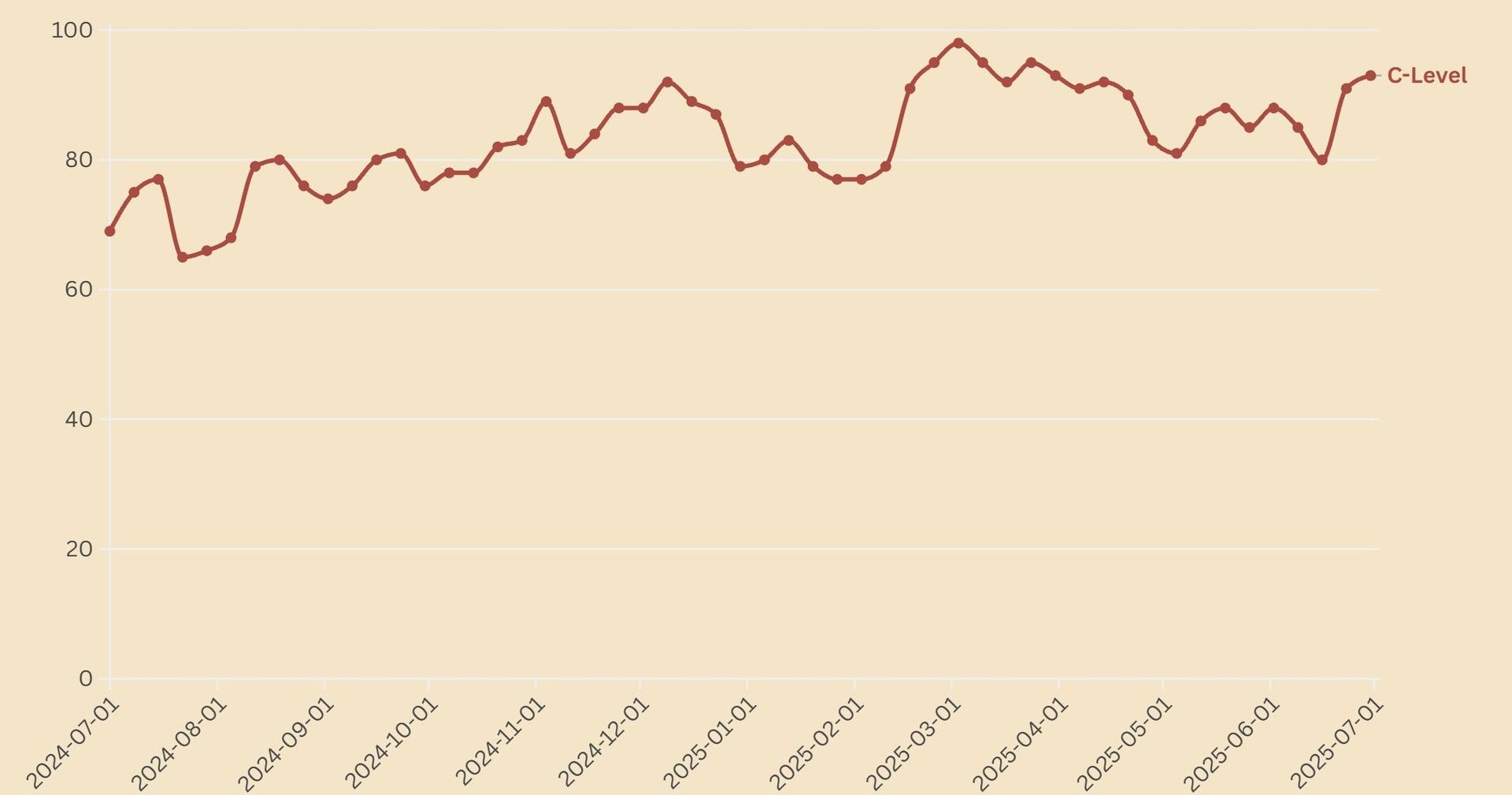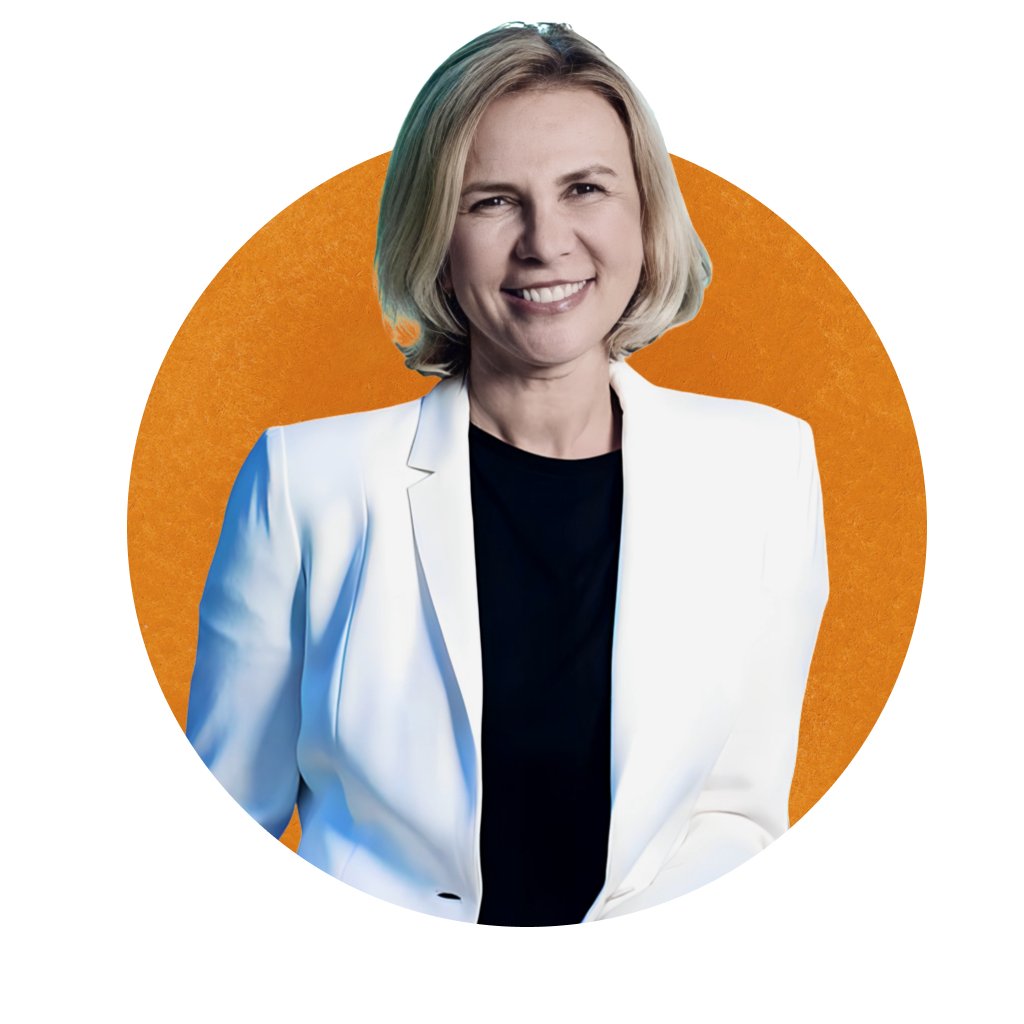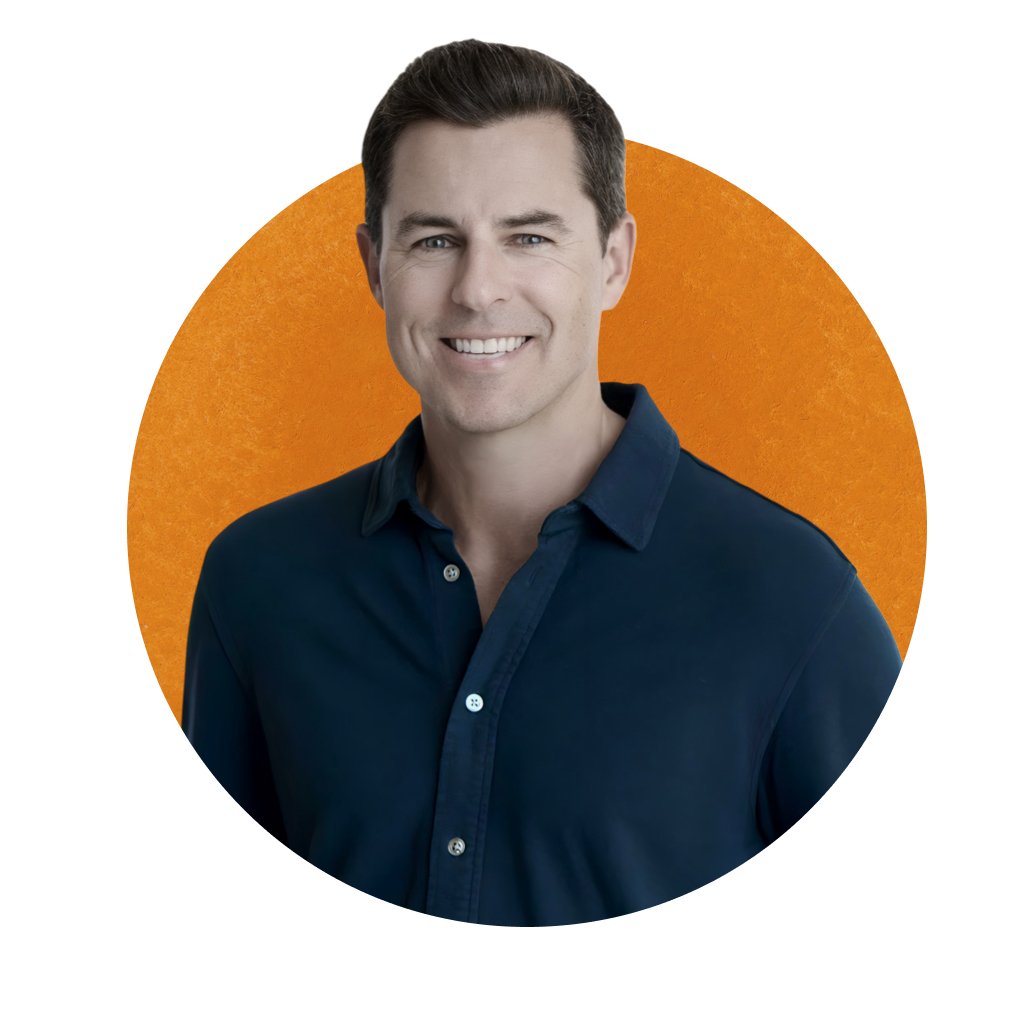- CMO Ladder
- Posts
- CMO Moves Mid-July Update
CMO Moves Mid-July Update
Ft. Estée Lauder, Vanta, and Webflow

CMO hiring spiked. Data proves it.
Over the last 12 months, C-level job postings in the U.S. have climbed from 69 to 93, a tidy 34.8% increase year-over-year. Salaries have followed suit, jumping 41% to a median of $274,997 as of the end of Q2 (June 30, 2025). Not bad for a job market where broader marketing hiring has been slowing down.

C-level Marketing Vacancy Trend [July 1,2024 - June 30,2025]
Companies may be scaling back on junior hires, but they’re still keen to lock in senior leadership. And this only scratches the surface: many of the top roles, especially at Fortune 500 firms, never even make it to the job boards. They’re handled quietly through executive search.
Case in point: 23 new CMOs have stepped into the role in just the first half of July. Of those, 14 were women and 9 men. Only 3 were internal promotions; the rest came from outside, largely pulled from competitors in similar sectors. Interestingly, not a single hire crossed industries - zero “industry traveler” in the mix so far this month. Our regular readers would know that this is a bit of an anomaly. On the other hand, 10 of the new appointees are stepping into the C-suite for the first time.
Geographically, the U.S. continues to lead, with 13 new CMOs spread across 9 states. California and New York came out on top with 3 apiece. Internationally, 10 appointments were made across 9 countries, including 2 in England and one each in Canada, Denmark, France, India, Ireland, Japan, the Philippines, and Spain.
Tech is still the front-runner industry-wise, accounting for 9 of the new hires. Professional Services, Retail, and Healthcare each added 3, while Manufacturing saw 2 fresh appointments. Let’s see if the second half of July keeps up the pace.
CMO Appointments by Sector:
Tech: 9
Professional Services: 3
Retail: 3
BioTech, Pharma, Healthcare: 3
Manufacturing: 2
Construction: 1
CPG: 1
Financial Services: 1
ESTEE LAUDER
I’ve been watching Estée Lauder attempt to find its digital mojo for quite some time now, so the decision to hand Aude Gandon the newly created Chief Digital and Marketing Officer remit feels like a real turning point. She starts on 1 August and reports straight to President and CEO Stéphane de La Faverie, a clear sign that every consumer touchpoint, commerce, media, store design, even customer care, now answers to just one desk.
Gandon arrives with the kind of blended résumé I assume the board wanted: 5 years making Android and Chrome feel like brands at Google, followed by a global CMO role at Nestlé where she set hard public targets for online sales and first-party IDs. Her reputation for collapsing digital and brand teams into a single operating model will work well for her here and may present opportunities for new agency suitors.
The numbers explain the urgency for this role. Third-quarter revenue slipped to $3.55 billion, about 9% lower year-over-year, despite cost cuts, which allowed EPS to beat expectations at $0.65. Travel retail is still struggling, and the share price has spent 12 months in the penalty box (it’s down by over half in the last five years, not pretty). I reckon the board is done waiting for a macro rebound and wants fresh oxygen.
Estée is already talking up a “Beauty Reimagined” turnaround plan that blends digital and physical retail and leans hard into AI for trend spotting and hyper-personalized recommendations that we’ve come to expect from newer D2C cosmetics players. The Wall Street Journal called the company a late digital adopter only yesterday and framed Gandon as the fix. I noticed the wording around her role: she is expected to “elevate the consumer journey at every touch point,” which reads like permission to rewrite org charts as needed. (We’re ready to hire your first line, Ms. Gandon!)
She will inherit an Adobe Firefly partnership that is pumping out marketing assets at speed; internal creatives claim it removes the grind of making hundreds of ad variants but insist they will avoid fully synthetic beauty faces to stay on the right side of brand safety. That ethical line will matter if Gandon’s Google pragmatism collides with prestige-beauty ideals.
My best guess at her first 90 days: build a single ROI dashboard that forces brand teams to defend spend in real time, flatten the digital centre of excellence into cross-functional brand pods, and publish clear public targets for e-commerce and media mix the way she did at Nestlé. If she pulls that off, the share price may finally believe the turnaround story, and if she doesn’t, investors will know exactly who to ask!
VANTA
I’ve been tracking Vanta since its YC days, and Scott Holden’s arrival as CMO on 15 July feels like a real pivot point. Holden excelled in turning somewhat dry categories, Salesforce’s platform, ThoughtSpot’s analytics, Brex’s cards, into brands people actually remember. Now he owns Vanta’s whole GTM engine, from brand to demand. I reckon that combination of left-brain rigor and billboard swagger is exactly what Vanta needs right now.
Holden didn’t ease in. In his first week, he shouted about Vanta’s purchase of Riskey, a small vendor-risk outfit that swaps spreadsheets for live alerts. His LinkedIn note boiled it down: more vendors, more complexity, so let’s give teams real-time signal instead of after-the-fact audits. I think that framing: “act, not just react” is interesting.
Money isn’t a problem here. Vanta’s $150 million Series C in July 2024 pushed total funding past $450 million and valued the firm at $2.45 billion. By my [dreadful] math they’ve got 18 months of runway even if they keep spending like other GRC players. Meanwhile, the product list keeps growing: 30-plus frameworks, an AI Agent to draft policies, and hubs in Dublin and Sydney.
But rivals aren’t standing still. Drata, Secureframe, and a long tail of newcomers are racing to add the same AI bells and whistles. Prices will tighten; differentiation will come down to brand and trust. Holden already called out the old “Compliance that doesn’t SOC 2 much” billboard near his house, proof he gets that a sharp line can carry weight in a boring category. I expect more of that tone, plus founder-led storytelling that links compliance spend to revenue protection.
If it clicks, Vanta could shake off the “YC unicorn” label and become the default choice when a CFO asks for proof of controls. If it doesn’t, that valuation cushion will thin fast.
WEBFLOW
Webflow’s decision to hand the marketing reins to Dave Steer is easy to decode once you listen to him talk. In an interview about launch discipline, he warned,
“The stakes are high on launch day, but great marketers plan for day two and beyond.”
That long-arc mindset turned GitLab from an open-core darling into an IPO-ready platform, and Webflow now needs the same treatment.
Steer’s playbook mixes process and improvisation in equal measure.
“Too much checklist kills inspiration; too little leaves everyone mis-aligned,”
His workaround is simple: automate the rote steps so teams can focus on the story. The story, he says, must always orbit differentiation:
“Features are table stakes; the story wins.”
At GitLab he lived that rule by framing Duo AI not as another code co-pilot but as AI woven through every stage of software creation, which is an idea big enough to command enterprise budgets.
Dave has a novel and simple use case for AI that we can all learn from: he showed how AI can coach marketers themselves. In a panel last year, he described feeding sales-call transcripts into Claude and asking the model to play “skeptical buyer,” pausing mid-roleplay to suggest sharper value drivers. That, he said, kept customer centricity “on repeat, at scale.” Expect a similar loop at Webflow: community voices narrating launches, AI tools sharpening the pitch, metrics proving the lift.
Webflow has breathing room: over $330 million in funding, annual revenue north of $200 million, and a product that already pairs AI-powered site building with the design freedom people (including us at Taligence, who used it to build our website!) love. The real hurdle is convincing big-company IT teams still comfortable with WordPress or Adobe and likely very cost-savings focused, that no-code can handle grown-up requirements. If Steer can blend Webflow’s creative spark with the discipline he developed at GitLab, Webflow moves from indie favorite to enterprise must-have. If not, it risks being praised as “perfect, until the CIO walks in”.
Is your job search ready for a glow-up? Knowing which CMOs are moving and building and the empty seats they leave behind is exactly what you’ll get from a paid subscription to this newsletter. Sign up today to learn more about all of the 23 CMOs who changed jobs in July, plus 249 new CMOs announced earlier this year, and the 310 appointed in 2024.
Subscribe to Premium to read the rest.
Become a paying subscriber of Premium to get access to this post and other subscriber-only content.
Already a paying subscriber? Sign In.
A subscription gets you:
- • Access to all the movers in a downloadable format
- • Hand picked curated listings of $200K jobs in marketing
- • No annoying ads


